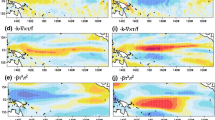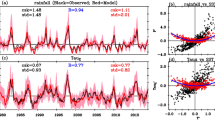Summary
Interannual modes are described in terms of three-month running mean anomaly winds (u″,v″), outgoing longwave radiation (OLR″), and sea surface temperature (T ″* ). Normal atmospheric monsoon circulations are defined by long-term average winds (u n,v n) computed every month from January to December. Daily winds are grouped into three frequency bands, i.e., 30–60 day filtered winds (u L,v L); 7–20 day filtered winds (u M,v M); and 2–6 day filtered winds (u S,v S). Three-month running mean anomaly kinetic energy (signified asK ″L , K ″M , andK ″S , respectively) is then introduced as a measure of interannual variation of equatorial disturbance activity. Interestingly, all of theseK ″L , K ″M , andK ″S perturbations propagate slowly eastward with same phase speed (0.3 ms−1) as ENSO modes. Associated with this eastward propagation is a positive (negative) correlation between interannual disturbance activity (K ″L , K ″M , K ″S ) and interannualu″ (OLR″) modes. Namely, (K ″L , K ″M , K ″S ) becomes more pronounced than usual nearly simultaneously with the arrival of westerlyu″ and negativeOLR″ (above normal convection) perturbutions. In these disturbed areas with (K ″L , K ″M , K ″S >0), upper ocean mixing tends to increase, resulting in decreased sea surface temperature, i.e.T ″* ≦0. Thus, groups (not individual) of equatorial disturbances appear to play an important role in determiningT ″* variations on interannual time scales. HighestT ″* occurs about 3 months prior to the lowestOLR″ (convection) due primarily to radiational effects. This favors the eastward propagation of ENSO modes. The interannualT ″* variations are also controlled by the prevailing monsoonal zonal windsu n, as well as the zonal advection of sea surface temperature on interannual time scales. Over the central Pacific, all of the above mentioned physical processes contribute to the intensification of eastward propagating ENSO modes. Over the Indian Ocean, on the other hand, some of the physical processes become insignificant, or even compensated for by other processes. This results in less pronounced ENSO modes over the Indian Ocean.
Similar content being viewed by others
References
Barnett, T. P., 1983: Interaction of the monsoon and the Pacific trade wind system at interannual time scale. Part I: The equatorial zone.Mon. Wea. Rev.,111, 756–773.
Lau, K.-M., Shen, S. H., 1988: On the dynamics of intraseasonal oscillation and ENSO.J. Atmos. Sci.,45, 1781–1797.
Lukas, R., Hayes, S. P., Wyrtki, K., 1984: Equatorial sea level response during the 1982–1983 El Niño.J. Geophys. Res.,89, 10425–10430.
Meehl, G. A., 1987: The annual cycle and interannual variability in the tropical Pacific and Indian Ocean regions.Mon. Wea. Rev.,115, 27–50.
Murakami, T., 1988: Relationship between sea surface temperature and outgoing longwave radiation on intraseasonal time scales. Tenki,J. Meteor. Soc. Japan,35, 715–722.
Murakami, T., Sumathipala, W. L., 1988a: Equatorward surges, equatorial westerlies and convection on interannual and intraseasonal time scales. UHMET88-02, Department of Meteorology, University of Hawaii, Honolulu, Hawaii, U.S.A.
Murakami, T., Sumathipala, W. L., 1988b: Relationship between outgoing longwave radiation and sea surface temperature on interannual time scales. UHMET88-03, Department of Meteorology, University of Hawaii, Honolulu, Hawaii, U.S.A.
Murakami, T., Sumathipala, W. L., 1989: Westerly bursts during the 1982/83 ENSO.J. Climate,2, 71–85.
Yasunari, T., 1987: Global structure of the El Niño/Southern Oscillation. Part I: El Niño composites.J. Meteor. Soc. Japan,65, 67–98.
Yasunari, T., 1988: Global teleconnections associated with the Asian monsoon and the ENSO. Jacob Bjerknes Symposium on Air-Sea Interaction, February 1–5, 1988, Anaheim, California.
Author information
Authors and Affiliations
Additional information
With 10 Figures
Contribution No. 89-6, Department of Meteorology, University of Hawaii, Honolulu, Hawaii.
Rights and permissions
About this article
Cite this article
Murakami, T. Equatorial disturbances, monsoons, and 1982–1983 ENSO. Meteorl. Atmos. Phys. 44, 85–100 (1990). https://doi.org/10.1007/BF01026812
Received:
Revised:
Issue Date:
DOI: https://doi.org/10.1007/BF01026812




